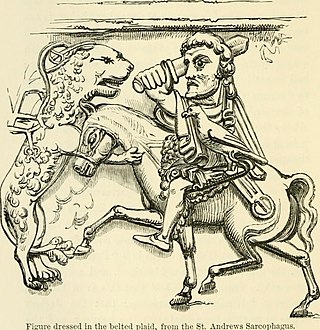
The loathly lady, is a tale type commonly used in medieval literature, most famously in Geoffrey Chaucer's The Wife of Bath's Tale. The motif is that of a woman who appears unattractive but undergoes a transformation upon being approached by a man in spite of her unattractiveness, becoming extremely desirable. It is then revealed that her ugliness was the result of a curse which was broken by the hero's action.
The glaistig is a ghost from Scottish mythology, a type of fuath. It is also known as maighdean uaine, and may appear as a woman of beauty or monstrous mien, as a half-woman and half-goat similar to a faun or satyr, or in the shape of a goat. The lower goat half of her hybrid form is usually disguised by a long, flowing green robe or dress, and the woman often appears grey with long yellow hair. A sighting of the glaistig is rare, but the loud cries and wails would often be heard.

The Wonderful Birch is a Finnish/Russian fairy tale. A variant on Cinderella, it is Aarne–Thompson folktale type 510A, the persecuted heroine. It makes use of shapeshifting motifs. Andrew Lang included it in The Red Fairy Book.
"Cap-o'-Rushes" is an English fairy tale published by Joseph Jacobs in English Fairy Tales.
The Red Ettin or The Red Etin is a fairy tale collected by Joseph Jacobs. It was included by Andrew Lang in The Blue Fairy Book.

"Katie Woodencloak" or "Kari Woodengown" is a Norwegian fairy tale collected by Peter Christen Asbjørnsen and Jørgen Moe in Norske Folkeeventyr. Andrew Lang included it in The Red Fairy Book.

Popular Tales of the West Highlands is a four-volume collection of fairy tales, collected and published by John Francis Campbell, and often translated from Gaelic. Alexander Carmichael was one of the main contributors. The collection in four volumes was first published in 1860–62 in Edinburgh. A new edition appeared under the auspices of the Islay Association in 1890–93. Campbell dedicated the work in 1860 to the son of my Chief, the Marquess of Lorne.
How Ian Direach got the Blue Falcon is a Scottish fairy tale, collected by John Francis Campbell in Popular Tales of the West Highlands. He recorded it from a quarryman in Knockderry, Roseneath, named Angus Campbell.
"Tattercoats" is an English fairy tale collected by Joseph Jacobs in his More English Fairy Tales.
"The Marriage of Sir Gawain" is an English Arthurian ballad, collected as Child Ballad 31. Found in the Percy Folio, it is a fragmented account of the story of Sir Gawain and the loathly lady, which has been preserved in fuller form in the medieval poem The Wedding of Sir Gawain and Dame Ragnelle. The loathly lady episode itself dates at least back to Geoffrey Chaucer's "Wife of Bath's Tale" from The Canterbury Tales. Unlike most of the Child Ballads, but like the Arthurian "King Arthur and King Cornwall" and "The Boy and the Mantle", "The Marriage of Sir Gawain" is not a folk ballad but a song for professional minstrels.
"The Goose-Girl at the Well" is a German fairy tale collected by the Brothers Grimm. It is Aarne-Thompson type 923.
The Daughter of the Skies is a Scottish fairy tale collected by John Francis Campbell in Popular Tales of the West Highlands, listing his informant as James MacLauchlan, a servant from Islay.
"The King Who Wished to Marry His Daughter" is a Scottish fairy tale collected by John Francis Campbell in Popular Tales of the West Highlands, listing his informant as Ann Darroch from Islay.
"The Brown Bear of the Green Glen" is a Scottish fairy tale collected by John Francis Campbell in Popular Tales of the West Highlands, listing his informant as John MacDonald, a "Traveling Tinker". He also noted the parallels with The Water of Life.
The Young King Of Easaidh Ruadh is a Scottish fairy tale collected by John Francis Campbell in his Popular Tales of the West Highlands, listing his informant as James Wilson, a blind fiddler, in Islay. Andrew Lang included a variant in The Lilac Fairy Book, as "The King of the Waterfalls", listing his source West Highland Tales.
"The King of Lochlin's Three Daughters" is a Scottish fairy tale collected by John Francis Campbell in his Popular Tales of the West Highlands, listing his informant as Neill Gillies, a fisherman near Inverary.
The Three Daughters of King O'Hara is an Irish fairy tale collected by Jeremiah Curtin in Myths and Folk-lore of Ireland. Reidar Th. Christiansen identified its origin as Co. Kerry.
"The Rider Of Grianaig, And Iain The Soldier's Son" is a Scottish fairy tale collected by John Francis Campbell in Popular Tales of the West Highlands (1860–62), listing his informant as Donald MacNiven, a lame carrier, in Bowmore, Islay; the story was written down by Hector MacLean on 5 July 1859. Andrew Lang included it in The Orange Fairy Book (1906) as "Ian, the Soldier's Son".
The Three Crowns is an Italian literary fairy tale written by Giambattista Basile in his 1634 work, the Pentamerone.
In Scottish folklore, the beithir is a large snakelike creature or dragon.




